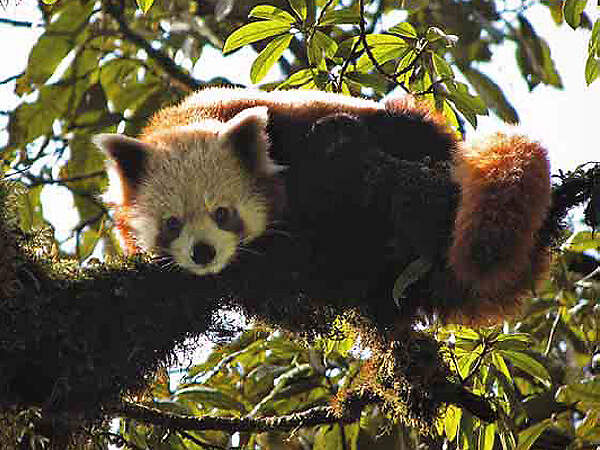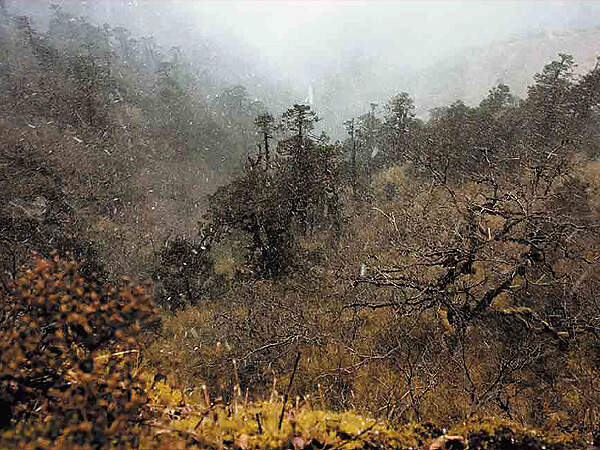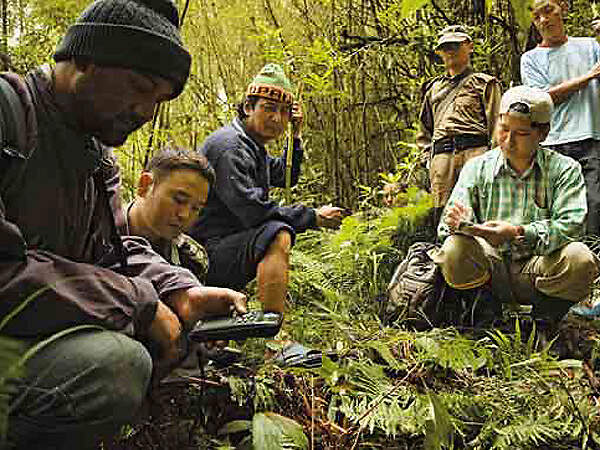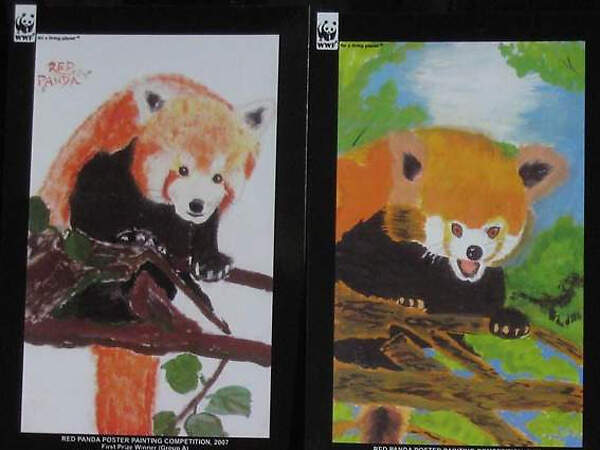CORMACK GATES,C., FREESE, C. H., GOGAN,P. J. P. & KOTZMAN, M. (eds., 2010)
American Bison - Status Survey and Conservation Guidelines 2010.
134 Seiten. IUCN, Gland, Switzerland. ISBN: 978-2-8317-1149-2
Summary:
The publication of this IUCN American Bison Status Survey and Conservation Guidelines is timely owing to a recent convergence of factors: new research findings on bison genetics and ecology, assessment and awareness of the precarious status of many bison conservation herds, new initiatives by government and non-profit institutions to improve management of existing herds and to establish conservation herds, growing interest among Native Americans in restoring bison as part of their cultural heritage, and an increasing awareness by the commercial bison industry that conservation of wild-type bison is in the longterm interest of the industry. There is also a growing body of evidence that the biodiversity of ecosystems within the original range of bison can benefit from bison restoration, from the desert grasslands of northern Mexico, through the Great Plains, to the lowland meadow systems of interior Alaska. The ten chapters of this book examine these and other aspects of the biology and conservation of the species, and offer guidelines for what we anticipate will be a new era of bison conservation in North America. Under the auspices of the IUCN American Bison Specialist Group, twenty-nine chapter coordinators and contributors share their knowledge and ideas in this comprehensive review of the diverse topics that need to be considered by researchers, managers, policy makers and others interested in restoring and conserving this magnificent animal.
Chapter 1 Introduction: The Context
Chapter 2 History of Bison in North America
Chapter 3 Taxonomy and Nomenclature
Chapter 4 Genetics
Chapter 5 Reportable or Notifiable Diseases
Chapter 6 General Biology, Ecology and De
Chapter 8 Legal Status, Policy Issues and Listings
Chapter 9 Conservation Guidelines for Population, Genetic, and Disease Management
Chapter 10 Guidelines for Ecological Restoration of Bison
cormack-biblio
RAVUSSIN, P.-A. et al. (2015)
Quel avenir pour la chouette de Tengmalm Aegolius funereus dans le massif du Jura?
Nos Oiseaux: 62, 5-28. www.chouette-gobe.ch
ravussin-biblio
KELLER, V. (1999)
Kolbenenten sind im Kommen - Ein farbenprächtiger Gast aus Spanien erobert unsere Seen.
ORNIS 1999 (6): 34-37.
Verbreitung:
Von Südwedsteuropa her breitet sich die Kolbenente (Netta rufina) immer weiter nach Osten aus. Ihr Gesamtbestand hat allerdings nicht zugenommen, nur die Verteilung hat geändert. Was lockt die Kolbenente aus den warmen Überwinterungsgebieten in Spanien an unsere kalten Seen?
ZHOU, C., XU, L. & ZHANG, Z. (2015)
Dramatic decline of the Vulnerable Reeves’s pheasant Syrmaticus reevesii, endemic to central China.
ORYX 49 Nr. 3 (Juli 2015): 529-534
Abstract
The current status and distribution of the Vulnerable Reeves’s pheasant Syrmaticus reevesii, endemic to central China, is poorly known. To obtain updated information on its status we selected 89 candidate sites in six provinces and one municipality in central China and conducted interviews and field surveys from April 2011 to April 2012. Interviews demonstrated the pheasant has disappeared from 46% of the surveyed sites. Our results also revealed a population decline at 46 sites, including protected areas, although population densities in protected areas were higher than those in non-protected areas. Eightythree, 26 and 20% of the surveyed sites had evidence of poaching, habitat loss and use of poison, respectively, which were the three major threats to this species. To ensure the long-term survival of Reeves’s pheasant in China, protection and management need to be enforced in both protected and non-protected areas. We recommend that this species should be upgraded to a national first-level protected species in China and recategorized as Endangered on the IUCN Red List.
zhou-biblio
CAMIÑA CARDENAL, A. (2011)
Gänsegeier in Mitteleuropa.
Der Falke 58 (Sonderheft): 46-48.
Zusammenfassung:
Bis in die 1990er Jahre waren Gänsegeier in Mitteleuropa eher eine Ausnahmeerscheinung. Die Beobachtungshäufigkeit lag zwischen den Jahren 1800 und 2005 für Deutsch-land bei durchschnittlich 0,86 Beobachtungen pro Jahr. Seit dem Jahr 2006 ist dieser Wert auf 25,1 Gänsegeier pro Jahr angestiegen. Mehr Vogelbeobachter und bessere Ausrüstung haben sicher zu diesem Anstieg beigetragen, es gibt aber auch andere Gründe. Immer wieder wird dafür die Zunahme des Geierbestandes in Frankreich und vor allem in Spanien, verbunden mit Nahrungsengpässen angeführt. Im Artikel wird das Vorkommen von Geiern in Mitteleuropa interpretiert.
PERELADOVA, O. (2013)
Restoration of Bukhara deer (Cervus elaphus bactrianus Lydd.) in Central Asia in 2000-2011.
Deer Specialist Group Newsletter 25 (März 2013): 19-30.
ISSN 2312-4644
Abstract:
The goal of this study was to monitor the recovery of the populations of Bukhara deer (BD) within its historical distribution area in Central Asia. Restoration activities were based onscientific knowledge gained from a 30 year study of its ecology, behavior and communication. The research methods included: mapping acoustic communication-recording and acoustic analyses of the vocalizations; visual recording of animals in the field; long-term visual observations of individually recognized animals; recording and mapping of traces.
In 1989 there were around 900 BD in all groups, with potential for population growth up to 4000-5000 animals. The Bukhara deer restoration activities (WWF project) included technical support for the nature reserves still inhabited by the species, anti-poaching activities, reintroduction in suitable sites at the limits of the historical distribution, ecological education, local communities involvement, etc. All restoration activities were accompanied by species monitoring. As a result of this scientifically based approach to species restoration the total Bukhara deer number increased from 350 in 1999 to 1900 in 2011; the efficiency and cost effectiveness of the suggested methods were proven by the results obtained.
STRAUSS, R., GRAUER, A., BARTEL, M., KLEIN, R., WENZELIDES, L., GREISER, G., MUCHIN, A., NÖSEL,H. & WINTER, a. (2008)
The German wildlife information system: population densities and development of European Hare (Lepus europaeus PALLAS) during 2002–2005 in Germany.
European Journal of Wildlife Research, February 2008, 54 (1): 142-147.
Abstract:
The German Wildlife Information System, founded in 2001, is a long-term monitoring program documenting occurrence, number, and development of game populations throughout Germany. Population numbers are recorded by standardized counting methods in so-called reference areas. The population densities of the European hare are calculated by spotlight strip censuses in the reference areas each spring and autumn all across Germany. From 2002 to 2005, the censuses were carried out by local hunters in 510 to 676 reference areas each year. During these years, the calculated spring densities increased significantly from 11.0 (2002) to 14.5 hares/km2 (2005) nationwide. The overall increase in spring densities was primarily caused by the population rise from spring 2003 to 2004, which correlates with the high net growth rate in 2003. In 2005, the number of counted hares varied between less than 1 and more than 107 hares/km2 in spring and between 0 and more than 170 hares/km2 in autumn. Because of differing landscapes in Germany, three regions were differentiated. In spring 2005, the average population densities (median) in East Germany (5.4 hares/km2) and Southwest Germany (14.6 hares/km2) were significantly lower than in Northwest Germany (23.9 hares/km2). These regional differences had been similarly distinct in former years.
strauss_biblio
Pandaschutz in Sikkim
Erforschung und Schutz des Kleinen Panda in Sikkim
|
|
Mit finanzieller Unterstützung des Verbands der Zoologischen Gärten (VdZ) e.V. und verschiedener seiner Mitgliedzoos und in Zusammenarbeit mit der Abteilung für Forst-, Umwelt- und Wildtiermanagement (FEWMD) der Regierung von Sikkim hat der WWF 2006 eine Studie initiiert, die darauf abzielte, das potenzielle Verbreitungsgebiet und den Populations-Status des Roten Panda in Sikkim zu beschreiben und zu bewerten. Dazu wurde zunächst eine Klassifizierung der Landnutzung des Bundesstaates durchgeführt, um Aussagen über den potenziell zur Verfügung stehenden Lebensraum des Roten Panda treffen zu können. Des Weiteren wurden feldbiologische Studien unternommen, um Informationen über Lebensraumansprüche und Bestandsdichte der Katzenbären zu erhalten. Mittlerweile ist daraus ein Programm geworden, das immer noch weitergeführt und ausgedehnt wird. Von Mai 2007 bis Januar 2009 wurden in vier Schutzgebieten (Barsey Rhododendron Sanctuary, Pangolakha Wildlife Sanctuary, Kyongnosla Alpine Sanctuary und Fambong Lho Wildlife Sanctuary) feldbiologische Untersuchungen durchgeführt. Diese Feldstudien und Analysen haben den Bestand an Roten Pandas in Sikkim auf 225 bis 378 erwachsene Tiere geschätzt, die sich auf etwa 51% der Landfläche Sikkims verteilen. Um Bestand und Fortpflanzung dieser wenigen Individuen zu sichern, werden fortwährend weitere Maßnahmen vor Ort auf den Weg gebracht. Der Verband der Zoologischen Gärten und seine Mitgliedzoos unterstützen dieses Projekt regelmäßig. Leider konnte im Pangolakha Wildlife Sanctuary kein Nachweis von Kleinen Pandas erbracht werden. Vermutlich ist dies auf das massenhafte Absterben von Bambus-Futterpflanzen zurückzuführen. Die Regeneration des Bambus wird daher künftig beobachtet. Verwilderte Hunde sind neben dem Lebensraumverlust eine der Hauptbedrohungen für Rote Pandas. Daher wurden besonders empfindliche Regionen identifiziert, in denen gegen verwilderte Hunde vorgegangen werden soll, und in der Folge damit begonnen, die Hunde zu sterilisieren. In Workshops wird zusätzlich das Bewusstsein von Lokalbevölkerung und Regierungsbediensteten für die Bedrohung der Pandas durch verwilderte Hunde und andere Gefahren geschärft. Informiert wurden zum Beispiel 60 Mitarbeiter der Indischen Grenzschutzpolizei, die für Sicherheit in den Grenzregionen sorgen und gegen Schmuggel und andere illegale Aktivitäten vorgehen. An zehn Schulen wurde in Zusammenarbeit mit dem Himalaya Zoo in Ganktok ein Umweltbildungsprogramm durchgeführt. Auch sonst ist der Einbezug der lokalen Bevölkerung wichtig. 2013 konnte wurde nach intensiver Feld- und Lobbyarbeit ein neues Gemeindeschutzgebiet für den Kleinen Panda geschaffen, die 85 km2 große Pangchen Lakhar Community Conserved Area, wo nicht nur eine gesunde, sich fortpflanzende Panda-Population besteht, sondern auch andere seltene Tiere wie Leoparden und Kragenbären vorkommen. Tierart-Datenblatt: Kleiner Panda (Ailurus fulgens)Lebensraum: Gebirge Süd- und Südostasiens |
Literatur:
ZIEGLER, S., GEBAUER, A., MELISCH, R., SHARMA, B.K., GHOSE, P.S., CHAKRABORTY, R. et al. (2010)
Zurück zu Kleiner Panda (Ailurus fulgens)
Weiter zu Tenrekartige - Allgemeines
WAYNE, A.F., MAXWELL, M.A., WARDA, C.G., VELLIOSA, C.V., WILSON, I., WAYNE, J.C. & WILLIAMS, M.R.(2015)
Sudden and rapid decline of the abundant marsupial Bettongia penicillata in Australia.
Oryx 49 (1) / January 2015: 175-185. Fauna & Flora International
DOI: http://dx.doi.org/10.1017/S0030605313000677 Published online: 29 November 2013
Abstract:
The woylie Bettongia penicillata is categorized as Critically Endangered, having declined by c. 90% between 1999 and 2006. The decline continues and the cause is not fully understood. Within a decline diagnosis framework we characterized the nature of the decline and identified potential causes, with a focus on the species’ largest populations, located in south-west Western Australia. We described the spatio-temporal pattern of the decline, and several attributes that are common across sites. We categorized the potential causes of the decline as resources, predators, disease and direct human interference. Based on the available evidence the leading hypothesis is that disease may be making woylies more vulnerable to predation but this remains to be tested. No substantial recoveries have been sustained to date, and one of the three remaining indigenous populations now appears to be extinct. Therefore, verifying the factors causing the decline and those limiting recovery is becoming increasingly urgent. Active adaptive management can be used to test putative agents, such as introduced predators. Insurance populations and ecological monitoring should also be included in an integrated conservation and management strategy for the species.
wayne-biblio
SCHALLER, G.B., LIU, W. & WANG, X. (1996)
Status of Tibet red deer.
ORYX 30 (4): 269-274. ISSN 0030-6053
Abstract:
Reports of the Tibet red deer, a subspecies of Cervus elaphus, have been so few in recent years that there were fears that the animal was extinct. A survey in a mountainous region of south-east Tibet in October 1995 found evidence that a few deer survive in one small area and possibly two others in high-altitude valleys of the tributaries of the Subansiri River. The most exciting finding of the survey, however, was an estimated 200-strong population of this deer in high rolling hills near the village of Zhenqi, north of the Yarlung Tsangpo River. This is the only known viable population of the deer and, although some hunting occurs, including by professional poachers from outside Tibet, the fact that it survives is an indication of the tolerance of the local people. The Tibet forest Bureau has agreed to fund guards and to establish a reserve for the deer in co-operation with local people.
schaller-biblio





